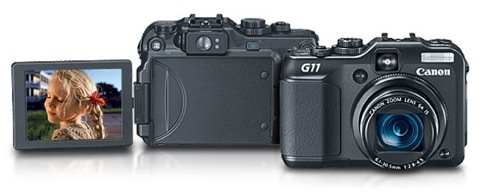By Steve Baczewski
Canon’s (http://www.usa.canon.com) G-series PowerShot cameras consist of high-end point-and-shoots. They’re often used by professional photographers as a second camera because they produce quality images, are relatively compact, and capture both RAW and JPEG formats.
The US$499.99 G11 succeeds Canon’s popular G10. It has a new Vari-angle 2.8-inch LCD and a new CCD sensor. The G11 is slightly bigger but otherwise looks remarkably similar to the G10. It shares the same DIGIC 4 Image Processor and 5x optical zoom lens, with an effective range equivalent to 28–140mm, supported by Canon’s Optical Image Stabilizer.
The main change is that Canon took this opportunity to break with a mindless marketing trend of adding more megapixels with each successive camera. The G11 is a 10-megapixel camera compared to the G10’s 14-megapixels. The reason for the resolution downgrade is simple: cleaner image quality at higher ISOs and less noise in low light. Canon claims to have gained as much as two stops over the G10. I compared the two cameras and paid special attention to low-light situations and noticed on my display at a 1:1 enlargement, a definite one-stop improvement.
The standard ISO range has been extended to 3200 and a new automatic Low Light mode has been added. This mode adjusts the ISO up to 12,800 relative to the available light, but at a reduced resolution of 2.5 MBs. It’s insurance that you’ll get an image.
For the best quality, if you shoot RAW and don’t go over ISO 400 you can make excellent 17 x 22-inch prints. Canon decided not to add HD video capability but stuck with the standard 640×480 resolution. The video quality is quite good but, for some, this omission might be a deal-breaker.
The black metal body is solid, large enough to get a good grip, and small enough to fit in a large coat pocket with the lens retracted. A hot shoe is located on top and a built-in flash at the top-left corner. The back-right side has a four-way navigational control dial surrounded by buttons.
While shooting, your thumb naturally falls across the controller, so photographers with large hands might unintentionally push a button. You view and compose your shots using either the optical viewfinder or LCD. The optical viewfinder adjusts as you zoom but it’s undersized and the coverage is too small to be practical for viewing or composing. Happily you can view and compose on the LCD in bright light, and the articulated LCD makes it easy to compose shots at acute angles. It definitely trumps a fixed LCD. The lens zooms smoothly for the most part, but I found it difficult to stop precisely at the desired focal length.
Kudos to Canon for a straightforward design that improves performance. On top of the G11 are three large dedicated analog control dials that use precision click stops for adjusting shooting mode, exposure compensation, and ISO. I prefer the dials to an LCD interface and hope Canon will include dials for apertures and shutter speeds in the future. Scrolling the menus is simplified by a guide that appears at the bottom of the LCD giving clear explanations for each feature.
Using dedicated buttons, such as metering (spot, evaluative, and center weighted), flash, and macro photography for various functions also enhances performance. A function button displays a control panel on the LCD for quick access to frequently used features like white balance, bracketing, and image quality. The G11 is a solid, compact camera that delivers quality images and has sophisticated features. It’s well worth your consideration.
Rating: 8 out of 10
(This review is brought to you courtesy of “Layers Magazine”: http://www.layersmagazine.com ).

